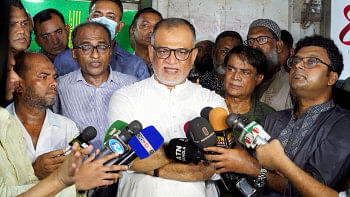Ensure sustainable urban dev: Experts
Urban development should be sustainable and inclusive so that every stratum of the society reaps its benefits in the long run.
Speakers said this at a roundtable discussion at Bangladesh University of Engineering and Technology (Buet) yesterday. The discussion was organised to come up with experts' suggestions as to how to implement the new urban agenda sketched out by the government.
Project-oriented development will fail to turn Dhaka into a liveable, modern mega city, they said. Instead, it will cause barriers to long-term solutions, said the speakers consisting experts on housing, transport, disaster resilience and urban governance.
Referring to the $3 billion metro rail project, Prof Shamsul Hoque of Buet's civil engineering department said the project had been taken up finally without meeting the preconditions.
There are at least two development steps to be made for mitigating Dhaka's traffic situation -- disciplining buses plying different routes and constructing Bus Rapid Transit route for uninterrupted travel on dedicated lanes.
The government skipped these steps that would involve no cost or minimum cost, and jumped to a mega project like the metro rail project that will not solve the entire problem, Shamsul said.
Speaking at the discussion, the experts said the Strategic Transport Plan and revised STP had comprehensive solutions with short-, medium- and long-term priorities, but different ministries, including the ones not having the mandate, took it upon themselves to implement various projects.
A modern Dhaka was kept in mind while making the plans, which could be replicated in other cities across the country. But the disaster that is taking place in the capital is encouraging similar situations elsewhere, they added.
Maruf Hossain, programme manager of Work for a Better Bangladesh Trust, said had there been a consistency in development, many high-cost projects like flyovers and elevated expressway would not have been needed.
The authorities should facilitate cycling and walking inside the city, which will solve 70 percent of the transport problem, he said.
Besides, people like garment workers, labourers would not be able to afford travel through metro rail or bus. They should have means to travel at minimum or without cost, Maruf added.
On affordable housing, Prof Shahidul Ameen, department of architecture at Buet, said, “If your only tool is a hammer, then all your problems will look like nails.”
He was very critical of the ideas that the Housing and Building Research Institute had come up with regarding cheaper and alternative materials for construction.
Low-cost housing and low-income housing were completely different things, he said. Low-income housing means affordable housing, he clarified, adding that all stakeholders and mechanisms should be involved, and funds should be allocated to bring housing solutions for all.
It is more complex than what it is thought of, he added.
Salma A Shafi, urban specialist, Centre for Urban Studies, said bringing housing solutions for all demands more research; data on requirements of different income groups, availability of land and financing are also necessary.
Unplanned urbanisation in Bangladesh created a risky, vulnerable living condition in cities, while it should have been the other way round, said Khurshid Alam, assistant country director of United Nations Development Programme.
Since disasters like earthquake does not happen frequently, people tend to take the risks it involves very lightly, said the experts. And so making them aware is a huge and important task in dealing with such disasters, they underscored.
The speakers also stressed the importance of taking all people -- disabled, indigenous, elderly, children, women -- into consideration when the government takes up any development agenda.

 For all latest news, follow The Daily Star's Google News channel.
For all latest news, follow The Daily Star's Google News channel. 



Comments